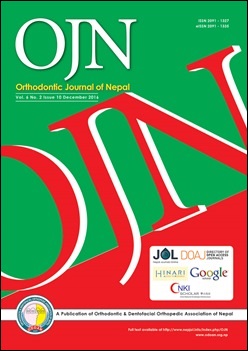Comparison of Two Different Orthodontic Bracket Recycling Techniques
DOI:
https://doi.org/10.3126/ojn.v6i2.17417Keywords:
bracket recycling, heating, sandblasting, shear bond strengthAbstract
Introduction: The cost of orthodontic treatment in most of the industrialized countries may considerably differ from those in third world countries. The lesser cost of orthodontic treatment, high pricing of orthodontic inventory and poor economic conditions of the people strengthen the notion of ‘recycling’ even more.
Objectives: To compare the shear bond strengths of .022 slot pre-adjusted edgewise brackets with conventional mesh base design recycled by two different chair-side techniques, one being flaming/heating and other being sandblasting.
Materials & Method: The sample involved eighty extracted human premolars with .022 slot pre-adjusted edgewise brackets (Orcmo, USA) bonded onto the lingual surface. After initial de-bonding the bracket base was studied under a scanning electron microscope at different magnifications for aperture size, mesh continuity and surface roughness. The brackets were re-bonded on to the labial surface of the same premolars and then debonded using a Universal Testing Machine to produce a shear force at the tooth bracket interface.
Result: The study showed highest bond strengths with the control group (111.52 ± 49.90 N) and least bond strengths with the heating/flaming group (63.71 ± 22.43 N). Reduced aperture dimensions and loss of mesh continuity were characteristics of the Heating group. Sand Blasting showed significantly higher bond strengths (100.42 ± 39.42 N) with considerably rougher mesh surface texture compared to heating group.
Conclusion: Sand blasting as a mode to reconditioned orthodontic bracket base provides a higher shear bond strength compared to orthodontic brackets reconditioned by heating/ flaming (p< .01).
Downloads
Downloads
Published
How to Cite
Issue
Section
License
Copyright © held by Orthodontic & Dentofacial Orthopedic Association of Nepal
- Copyright on any research article is transferred in full to the Orthodontic & Dentofacial Orthopedic Association of Nepal upon publication in the journal. The copyright transfer includes the right to reproduce and distribute the article in any form of reproduction (printing, electronic media or any other form).
- Articles in the Orthodontic Journal of Nepal are Open Access articles published under the Creative Commons CC BY License (https://creativecommons.org/licenses/by/4.0/)
- This license permits use, distribution and reproduction in any medium, provided the original work is properly cited.




